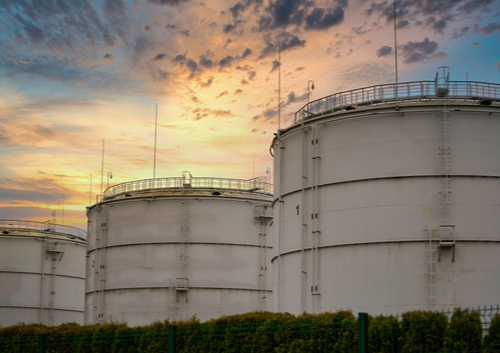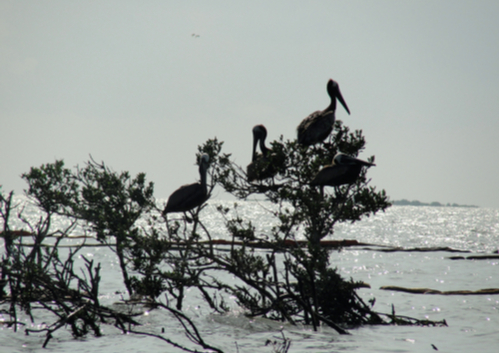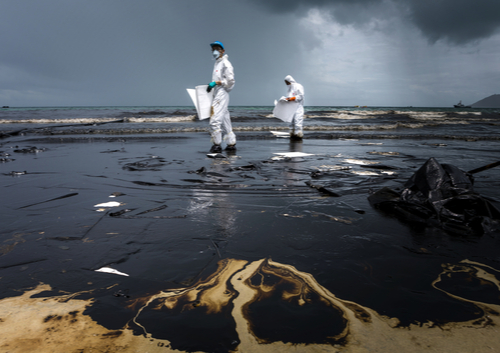ALLIANCE, La. (AP) - The oil industry has left a big footprint along the Gulf Coast, where a Delaware-sized stretch of Louisiana has disappeared. But few politicians would blame Big Oil for ecosystem abuse in a state where the industry employs up to 300,000 people and injects $73 billion into the economy.
Until now.
 Following the lead of Gov. John Bel Edwards, Louisiana political orthodoxy is being turned upside-down as prominent leaders of both parties join lawsuits seeking billions of dollars for environmental improvement projects.
Following the lead of Gov. John Bel Edwards, Louisiana political orthodoxy is being turned upside-down as prominent leaders of both parties join lawsuits seeking billions of dollars for environmental improvement projects.
Down in the pancake-flat bayou, it's not easy to see what made so much of the coast sink into the Gulf of Mexico.
Even when you climb onto the levee, buzzing with dragonflies, that keeps the old delta farming community of Alliance from being swallowed, all that's visible is marshland, stretching toward a green horizon.
But land's end is much closer now, and what remains has been disrupted. Access canals carved by the oil industry run straight as arrows, rusting signs warn of underwater pipelines and abandoned drilling platforms sink into the muck. As the Alliance refinery billows with fumes, the surrounding pastures are slowly sinking.
Louisiana remains the nation's second-largest crude oil producer and oil refiner after Texas, but the industry has been on the defensive since Edwards, a 49-year-old lawyer and Democrat, ended eight years of Republican leadership last November.
Publicly, he joined a campaign by local governments suing to hold the industry at least partly responsible for Louisiana's loss of 1,900 square miles of coast since the 1930s. Privately, he pushed for a pre-trial settlement to resolve all their claims.
"Our coast is in crisis," Edwards wrote in a letter to oil executives after their initial meeting in May, calling for an "amicable solution" to avoid years of litigation.
He was soon seconded by New Orleans Mayor Mitch Landrieu, whose family of Louisiana Democrats long supported Big Oil. Landrieu accused former state leaders of allowing the industry to cripple "in a generation or two what Mother Nature built in 7,000 years," and said the damage has spread "through the marsh like an infection.
In July, Vermilion Parish, deep in Louisiana's "Oil Patch," became the fourth local government to file claims against Exxon, Shell, Chevron, and dozens of other corporations. The agency overseeing flood protection for New Orleans also issuing. Republicans have joined in, from GOP-led parishes to Attorney General Jeff Landry.
"It's absolutely new," pollster Bernie Pinsonat said. "The oil companies are taking it seriously because you're talking about billions and billions of dollars."
This political shift can be traced to Hurricane Katrina, which shocked the nation and exposed the dire state of ecology in the Mississippi River's delta. Katrina alone tore up about 60 square miles of marsh around New Orleans in 2005.
At issue are oilfields like the one in Alliance, in Plaquemines Parish, where oil companies are accused of routinely abandoning open waste pits, carelessly dumping toxic brine and oilfield waste onto the marsh, and interrupting the delta's ebbs and flows by dredging thousands of miles of canals that weren't filled back in.
The oil industry blames the Army Corps of Engineers, whose levees deny the delta its natural deposits of silt and sand while channeling the Mississippi River out to sea. It also blames the clear-cutting of coastal forests more than a century ago, shipping channels that have sliced up the delta, and even the invasive nutria, an oversized marsh grass-eating rodent.
"It's just such a vague attempt by the plaintiffs to throw a blanket over an entire industry and hold it singularly responsible for a problem that's got multiple causes," said Robert Meadows, a Chevron lawyer.
The legal case requires analyzing thousands of coastal drilling permits and oil leases, putting prices on the unmitigated damage caused by each company, and then dueling over demands for compensation.
Scientists generally agree that between 30 percent and 40 percent of wetlands loss is attributable to drilling and its associated activities, said John Day, a Louisiana State University scientist and expert on the delta's problems.
"The factual basis is terribly strong: If I were a plaintiffs' counsel, I'd put on a five-day slide show narrated by geologists and hydrologists and wetlands scientists, and it would be devastating," said Oliver Houck, an environmental law professor at Tulane University in New Orleans.
Geologist Sherwood Gagliano, who has studied the coastal crisis since the 1960s, contends that extracting millions of barrels of oil and gas from below the surface has caused vast swaths of the coast to sink.
"It's like an Atlantis oilfield," Gagliano said. "There are well-heads sticking out of the water. Abandoned production platforms are now completely submerged. Oilfields developed on land are now under 5 or 10 feet of water. And that is happening all the way across the coast."
But F. Rivers LeLong Jr. calls the lawsuits a hypocritical "shakedown cruise" by the same governments that have long profited from drilling.
"They aren't the good guys any more than the oil companies were," said LeLong, whose father started the Kenmore Oil Co., which is named as a defendant because it worked the Alliance field before going out of business in 1973. "To act as though they were victims in the process is a fairly laughable characterization."
What's gone is gone, but the politicians hope to keep hundreds of other square miles from disappearing. They're envisioning huge projects to divert sediment flows from the Mississippi River and build up marsh flats, barrier islands, ridges, and swamp forests.
It would cost between $50 billion and $100 billion, and Louisiana doesn't expect to have more than $25 billion to spend.
Suing oil companies "is probably the only new potential source of revenue," said Mark Davis, who directs Tulane University's Institute on Water Resources Law and Policy. "Before you tax anybody, you're going to be required, I think, to show that you've tried every other alternative. Is there anybody who owes dollars that have not been collected for this purpose?"
Originally reported by Cain Burdeau of the Associated Press on August 5, 2016.
If you’d like to discuss the details of your case with a personal injury lawyer, please contact us to set up a consultation.
WASHINGTON, April 14 (UPI) -- The U.S. government said it's proposing new rules to prevent a repeat of the Deepwater Horizon tragedy, though the offshore drilling industry said it's ahead of the curve.
The Interior Department proposed dozens of new rules for offshore drilling equipment in order to ensure the series of failures that led to the 2010 rig disaster and subsequent oil spill won't happen again.
"Both industry and government have taken important strides to better protect human lives and the environment from oil spills," Interior Secretary Sally Jewell said in a statement.
"These proposed measures are designed to further build on critical lessons learned from the Deepwater Horizon tragedy and to ensure that offshore operations are safe," she added.
A district court in Louisiana ruled in September that BP's activities at the Macondo well, beneath the Deepwater Horizon rig in the Gulf of Mexico, amounted to willful misconduct. In its 152-page ruling, the court found a series of BP failures at the well "created the catastrophic situation" that led to the 2010 spill.
 The incident left 11 rig workers dead and led to the worst offshore oil spill in U.S. history.
The incident left 11 rig workers dead and led to the worst offshore oil spill in U.S. history.
BP leased the Deepwater Horizon from Transocean. In 2012, oil services company Halliburton was accused by BP of destroying test results on the cement used to seal the well beneath the rig.
The federal rules, if approved, would require companies to offer records up to third-party reviews and require backup equipment to close off any failed infrastructure.
The American Petroleum Institute, which represents the business interests of the oil and gas industry, said it's already created and revised more than 100 standards meant to ensure safe exploration and production.
"We are reviewing the proposed rules and hope they will complement industry's own efforts to enhance safety," API director for exploration and production Erik Milito said in a statement. "Improved standards for blowout preventers are one of the many ways industry has led the charge to make offshore operations even safer."
Original story by Daniel Graeber of UPI.
If you’d like to discuss the details of your case with a personal injury lawyer, please contact us to set up a consultation.
Nearly five years after Deepwater Horizon oil rig exploding, sending gallons upon gallons of oil into the Gulf of Mexico. Now, scientists have assessed the wildlife in the Gulf, and have found that it's still suffering from the oil spill.
"Five years later, wildlife in the Gulf are still feeling the impacts of the oil spill," said Collin O'Mara, president and CEO of the National Wildlife Federation, in a news release. "The science is clear that this is not over-and sea turtles, dolphins, fish, and birds are still suffering from the fallout. Holding BP fully accountable and using all fines and penalties to restore the Gulf of Mexico must be a national priority."
 In this latest study, the researchers examined wildlife populations. They found that dolphins on the Louisiana coast were found dead at four times historic rates in 2014, and there is increasing evidence that ongoing deaths are connected to the oil spill. In addition, endangered Kemp's ridley sea turtle nests have declined after the spill, even though they were increasing before it. Exposure to oil also has been shown to cause abnormal development in many species of commercially valuable fish, including mahi-mahi and the yellowfin tuna.
In this latest study, the researchers examined wildlife populations. They found that dolphins on the Louisiana coast were found dead at four times historic rates in 2014, and there is increasing evidence that ongoing deaths are connected to the oil spill. In addition, endangered Kemp's ridley sea turtle nests have declined after the spill, even though they were increasing before it. Exposure to oil also has been shown to cause abnormal development in many species of commercially valuable fish, including mahi-mahi and the yellowfin tuna.
"Wildlife from sperm whales to marsh ants are still feeling the effects of the disaster," said Ryan Fikes, a NWF restoration scientist. "But BP seems to prefer attacking scientists over accepting responsibility. It's time for BP to quit stalling so we can start restoring the Gulf."
These latest findings show how the Gulf is still being impacted by the spill, years after the Deepwater Horizon oil spill occurred. More specifically, it shows how not only wildlife is being impacted, but how the Gulf states may be affected as well as commercial species continue to fare poorly.
Originally posted by Catherine Griffin here.
If you’d like to discuss the details of your case with a personal injury lawyer, please contact us to set up a consultation.
Natural Resource Damage Assessment Trustees took issue with a news statement released Monday by BP, which claims the “…Gulf environment (is) returning to pre-spill conditions” although the Deepwater Horizon oil spill Natural Resource Damage Assessment Trustees are still assessing the injury resulting from the largest offshore oil spill in U.S. history.
"It is inappropriate as well as premature for BP to reach conclusions about impacts from the spill before the completion of the assessment," said the Natural Resource Damage Assessment Trustees in a press release. "Citing scientific studies conducted by experts from around the Gulf, BP misinterprets and misapplies data while ignoring published literature that doesn’t support its claims and attempts to obscure our role as caretakers of the critical resources damaged by the spill."
 More than 100 million gallons of spilled oil. The Deepwater Horizon oil spill is more than 10 times the size of the Exxon Valdez. From decades of experience with oil spills, experts say the environmental effects of this spill are likely to last for generations.
More than 100 million gallons of spilled oil. The Deepwater Horizon oil spill is more than 10 times the size of the Exxon Valdez. From decades of experience with oil spills, experts say the environmental effects of this spill are likely to last for generations.
The state and federal trustees are engaged in a rigorous, scientific process of injury assessment and are still analyzing the data, conducting studies, and evaluating what happened, according to the trustee's release.
BP's obligation under the Oil Pollution Act is to restore the public’s natural resources injured by the Deepwater Horizon spill to the condition they would have been in but for the spill and to compensate the public for the services of natural resources injured or lost.
Natural resource trustees from Florida, Alabama, Mississippi, Louisiana, Texas, NOAA, DOI, USDA, EPA, and DOD to the extent of DOD-owned lands are conducting the NRDA.
If you’d like to discuss the details of your case with a personal injury lawyer, please contact us to set up a consultation.
BP has abruptly switched legal strategies—again—in the multi-billion-dollar liability fight stemming from the April 2010 Gulf of Mexico oil spill. The company dropped a campaign to oust a settlement administrator it had accused of tolerating waste and fraud. The move seeks, in part, to mollify a federal judge in New Orleans who could sock BP with an enormous judgment in an environmental suit filed by the U.S. government.
As the five-year anniversary of the mammoth spill approaches, BP is looking to contain the already-considerable damage to its balance sheet and reputation. Beginning shortly after the disaster, which killed 11 offshore-rig workers and spewed millions of barrels of crude into the gulf, BP set aside billions for cleanup and damage claims and started making payouts. The company’s attempts to avoid protracted litigation failed, however, as certain Louisiana officials and plaintiffs’ lawyers pressed for compensation levels BP refused to meet. So far, the company has paid out more than $28 billion, but legal hostilities continue on several fronts. The eventual financial hit could easily reach $50 billion.
On one front, BP sought to remove a court-appointed administrator overseeing a settlement of certain private business and economic claims. The company accused the official, Patrick Juneau, of running a lax operation that accommodated fanciful claims unrelated to the 2010 spill. BP also alleged that Juneau tolerated rampant fraud.
Juneau denied wrongdoing. Plaintiffs’ lawyers doing business with his settlement organization said BP was trying to wriggle out of a pact that turned out to be more expensive than the company anticipated.
BP had modest success in the courts getting Juneau to modify his methods for determining damage amounts. But the company failed to persuade the U.S. Supreme Court to intervene and dramatically curtail payouts. Friday, BP made a court filing in New Orleans saying it would rescind its demand for Juneau’s removal.
“This marks the beginning of a new and more productive relationship between BP and the [Juneau] claims program,” John Mingé, chairman and president of BP America, said in a prepared statement. “We appreciate the work that has been done to develop and implement improved processes to, among other things, detect and prevent the payment of fraudulent claims. We share with Mr. Juneau and the claims facility the goal of compensating the people and businesses of the gulf under the terms of the settlement agreement.”
BP originally estimated the settlement at $7.8 billion. The company now concedes that the price tag could reach $9.9 billion. The Juneau operation has already paid out $4.9 billion.
One way of understanding BP’s move today is that, having beaten up on Juneau, the company believes it has done as much as it can to slow settlement payments. BP’s motive for burying the hatchet with a prominent Louisiana lawyer who pushed back hard against the attempt to oust him might also include a desire to mollify the judge who appointed the settlement administrator, Carl Barbier of the U.S. district court in New Orleans.
Judge Barbier has overseen the bulk of the litigation and settlements related to the 2010 spill. When BP attacked Juneau, the judge stood behind his appointee and fellow prominent member of the Louisiana bar. Now, Barbier is presiding over a separate civil trial in which the U.S. Justice Department is seeking in excess of $13 billion of additional damages from BP under the Clean Water Act. Making peace with Juneau looks like an attempt to mend relations with a jurist who has tremendous discretion to determine the penalty BP will pay for its negligence five years ago.
Paul Barrett, Bloomberg, as originally posted.
A federal judge on Thursday rejected BP’s request to cap its Deepwater Horizon oil spill liabilities at a level lower than the $4,300-per-barrel maximum U.S. prosecutors are seeking for environmental penalties.
U.S. District Judge Carl Barbier in New Orleans sided with the prosecutors, who had argued environmental regulators were instructed by Congress to raise statutory maximum fines to account for inflation.
Barbier said he hasn’t yet determined the actual amount of the civil penalty stemming from the Gulf of Mexico spill, which could run as high as $13.7 billion.
 The judge also ruled the highest fines that could be leveled against Anadarko Petroleum Corp., which owned 25 percent of the Macondo well, was $1,100 a barrel.
The judge also ruled the highest fines that could be leveled against Anadarko Petroleum Corp., which owned 25 percent of the Macondo well, was $1,100 a barrel.
“We disagree with the court’s decision, and continue to believe that neither the EPA nor the Coast Guard has the power to independently inflate the maximum penalty as Congress intended,” BP spokesman Geoff Morrell said in an emailed statement.
BP had wanted the judge to cap its fines at $3,000 per barrel, the level Congress had set in 1990, arguing only the U.S. attorney general had the authority to raise the fines — a task no attorney general had ever taken up.
But Barbier ruled the Environmental Protection Agency has the authority to adjust fines for inflation, pointing to “the very first section of the (Clean Water Act).”
The judge said the administrator EPA has jurisdiction over the fines to comply with the Inflation Adjustment Act, which requires federal agencies to raise deterrent penalties in line with inflation. Barbier also noted BP didn’t dispute EPA’s calculations were incorrect under that law.
Accepting BP’s position “would invalidate nearly every agency’s attempt to inflate civil penalties that can be sought in federal court,” Barbier said.
The EPA has set maximum environmental fines for oil spill liabilities at $4,300 per barrel of crude spilled. The Coast Guard set the penalties at $4,000 a barrel. Barbier had ruled in September BP was grossly negligent in the lead up to the spill, exposing the British oil company to the highest possible environmental fines.
“At the very least,” Morrell said, “fair notice was never provided as to which of those two agencies possessed the authority to inflate the penalty amount. We, therefore, believe the original statutory maximum penalty of $3,000 per barrel in the case of a gross negligence finding should remain in force and are considering all of our legal options.”
Originally published by Collin Eaton of Fuel Fix.
If you’d like to discuss the details of your case with a personal injury lawyer, please contact us to set up a consultation.
Oil from the Deepwater Horizon blowout in 2010 may have created a vast zone on the Gulf of Mexico floor where marine life is much sparser than before toxic petroleum settled there, according to studies presented Monday at a Houston conference on the BP oil spill.
Sperm whales are no longer feeding in a vast area of the Gulf of Mexico affected by the oil spill, an indication that there is nothing there to feed on, said Bruce Mate of the Hatfield Marine Science Center at Oregon State University, one of the scientists who conducted the study of 54 sperm whales from 2010 to 2013. Whales that typically made repeated dives over the area before the oil spill afterwards shunned large parts of it and made few dives around its edges as they searched for squid. Those areas are where millions of gallons of oil sank to the seabed, leading researchers to surmise that many organisms have perished over a 1,500 square-mile area.
Mate said he suspects the problem has to do with the food chain at the bottom of the Gulf, where there are no longer organisms to support the squid that are sperm whales’ main food source. Mate said the zone could become a serious problem for marine life if it fails to heal. ''My sense is that we’ve got a little bit of a tiger by the tail,'' he said. ''I think we need to be concerned about how long this lasts.''
The study was one of several presented by scientists at the 2015 Gulf of Mexico Oilspill and Ecosystem Science Conference. The conference at the Westin Galleria Hotel is scheduled to end Thursday. The spill, the largest in U.S. history, dumped 4.1 million barrels into the Gulf of Mexico, much of it broken up by chemical dispersants that caused the oil to spread in vast underwater plumes and sink to the bottom.
BP studies ongoing
A BP spokesman said, ''BP and the trustees continue to study the Gulf’s deepwater environment to gain a better understanding of how the current quantity and composition of deep sea marine species compare to those prior to the accident. Preliminary observations of the sea floor have identified marine life in, on and above the sea floor, both before and after the accident. Work to identify and document any changes in species type or abundance is ongoing.''
The possibility of an undersea expanse with diminished marine life was supported by another study showing a dramatic decline of fish on two oil-stained reefs. The number of fish on the Alabama Alps and the Roughtounged reefs dropped significantly in 2010 and continued to decline in 2011, said K.J. Sulak, a researcher with the U.S. Geological Survey.
Sulak said the decline showed a cascading effect, where the death of organisms lower on the food chain caused a die-off of larger animals that use them for food, which in turn affected the animals that prey on them.
Full impact not yet known
The studies and others presented are only nibbling at the edges of questions about the long-term effects of the oil spill on the health of the Gulf, said Pamela Plotkin, Monday’s conference organizer and director of the Texas Sea Grant College Program at Texas A&M University at College Station.
''We are not going to know the full impact for five to 10 years down the road,'' Plotkin said. ''We are just beginning to see the evidence that researchers are able to show to the public.''
Much of the key research into the effects of the oil spill is being kept under wraps because it is being funded under the Natural Resource Damage Assessment, which will be used by the U.S. government in court to determine how much BP should pay to restore the Gulf.
The Houston conference follows the Second International Kemp’s Ridley Symposium in November where researchers presented evidence for the first time linking the oil spill to a dramatic decline in the endangered Kemp’s ridley sea turtle.
Some of the studies showed that several types of marine life are recovering.
Originally published by Harvey Rice of the Houston Chronicle.
A federal appeals court panel has reaffirmed its ruling that BP is liable for federal Clean Water Act damages stemming from the 2010 Gulf of Mexico oil spill, the latest loss for the oil giant as it fights court decisions that could ultimately bring $18 billion in penalties.
The three-judge panel of the 5th U.S. Circuit Court of Appeals rejected arguments that there were errors in its June 4 ruling on BP’s Clean Water Act liability. The ruling released Wednesday night is not the final say from the court. BP and its minority partner in the Macondo well, Anadarko Petroleum Corp., have a request pending for the full 15-member court to reconsider the issue.
The June order and Wednesday’s follow-up were issued by Judges Fortunato Benavides, Carolyn Dineen King and James Dennis. They upheld U.S. District Judge Carl Barbier’s ruling holding the well owners are liable.
BP and Anadarko had argued they were not liable because equipment failure on the leased rig Deepwater Horizon caused the April 2010 disaster. An explosion on the rig killed 11 workers and sent millions of gallons of oil spewing into the Gulf in what became the nation’s worst offshore oil disaster.
Barbier also has ruled that BP was “grossly negligent” in the disaster. BP has asked Barbier to reconsider that finding, which, if it stands, would be a factor in whether the water act penalties for the company reach an estimated $18 billion.
Under the Clean Water Act, a polluter can be forced to pay from $1,100 to $4,300 per barrel of spilled oil. The higher limit applies if the company is found grossly negligent — as BP was in Barbier’s ruling. But penalties can be assessed at lower amounts.
By Kevin McGill, Associated Press
At approximately 8:30 a.m. CST on Monday, December 8, 2014, the United States Supreme Court released it's Order from the December 5, 2014 conference. This Order denied BP's request to have the highest Court in the United States hear arguments regarding the interpretation and validity of the Deepwater Horizon Settlement Agreement, which was entered in 2012.
Results of a third-party audit of the oil spill settlement program released Tuesday (Nov. 25) by claims administrator Patrick Juneau show the settlement program has correctly processed 99.5 percent of claims. The audit concluded the program is "well-designed and appropriate" and made no major recommendations for improvement.
The audit, conducted by Chicago-based McGladrey LLP, has become a focal point for BP in its fight to remove Juneau and challenge the settlement program, which it claims is riddled with fraud and errors.
In late October, BP asked a federal judge in New Orleans to force Juneau to turn over the audit, which it said had ballooned in cost from $1.6 million to $14 million. The British oil giant accused Juneau of purposely hiding the results.
The public release of the findings comes two weeks after a federal judge in New Orleans rejected BP's request to remove Juneau from his post due to a conflict of interest. BP said it is considering its options for appealing that decision.
In a statement, Juneau said the audit reinforces the program is running properly. He encouraged the public to review its findings.
"I am very grateful to all of those people who worked so hard to make this happen. It speaks volumes as to what has been accomplished to date," Juneau said.
BP Vice President Geoff Morrell said in a statement that BP was in the process of reviewing the report.
"The audit took place over the course of a year, and we have just received the report," Morrell said. "We are reviewing the materials and will have further comment, as appropriate."
McGladrey examined 1,852 claims out of 53,512 submitted to the court supervised settlement program since it was approved in 2012.
The total value of the reviewed claims was $741 million. More than half of the claims were for individual or failed business losses.
The key takeaways from McGladrey's audit include:
Of the 1,852 claims reviewed, 122 had calculation errors resulting in about $2.1 million in miscalculated awards.
Within the group of claims reviewed, the settlement program had an error rate of about 0.3 percent.
When the findings were applied to the larger group of claims, the error rate edged up only slightly to 0.5 percent. That translates to about $17.5 million in calculation errors for more than $3.7 billion in total awards.
In a filing with the court, McGladrey auditors said an error rate of less than 1 percent was "a significant accomplishment" given the size and complexity of the claims process.
"By any objective measure, these error rates are extremely low," the audit report states.
In a statement, lead plaintiffs' attorneys Steve Herman and Jim Roy, echoed the auditor's comments.
"BP wanted to see the McGladrey audit, and here it is: the CSSP gets claims right 99.5 percent of the time," Herman and Roy said. That 'is a significant accomplishment,' as stated by the Claims Program's independent audit committee."
The McGladrey audit is the second review of the claims program's internal operations.
A previous audit initiated by Juneau and completed by Minneapolis-based Clifton Larson Allen last year found the program was running properly.
BP objected to the results of that audit, and in late 2013 asked for a second audit by a different auditor. McGladrey was hired in October 2013 to complete the second audit.
A separate, court-ordered investigation into the program found that isolated cases of claims fraud did not impact the integrity of the claims process as a whole.
Investigators said payments would be able to move forward fairly and efficiently under Juneau's leadership.
Article by Jennifer Larino, published on Nola.com.
